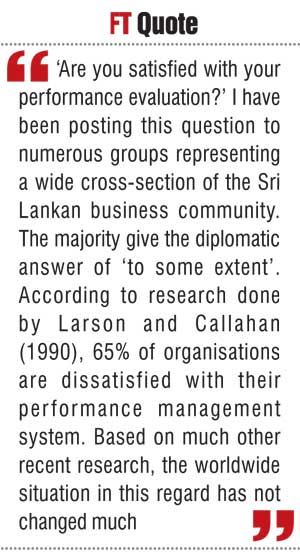Thursday Dec 12, 2024
Thursday Dec 12, 2024
Monday, 15 February 2016 00:00 - - {{hitsCtrl.values.hits}}

According to Jack Welsh, the biggest injustice employees can suffer is to be deprived of knowing how they are performing
I participated on invitation as a member of the advisory committee for the Ministry of Public Administration, recently. Among the key issues focused on, performance management as usual occupied a prominent place.
Finding the proper way of evaluating employee performance has been a perennial issue. Many attempts have been made, particularly in the public sector where the human resource management systems are comparatively low in presence. This article attempts to revisit some key fundamentals of employee performance evaluation (EPE) with reference to both the public and private  sectors.
sectors.
Overview
Performance is all about delivering results, fulfilling expectations. A performance management system of an organisation should answer the what, why and how aspects of organisational performance.
My focus today is on employee performance, particularly, on how it is evaluated. Employee performance evaluation (EPE) can be a treasure or torture based on a variety of contributing factors. They can be institutional as well as individual. Performance-oriented culture where employees are clearly aware of what they are supposed to do in order to achieve organisational objectives is one such example.
‘Are you satisfied with your performance evaluation?’ I have been posting this question to numerous groups representing a wide cross-section of the Sri Lankan business community. The majority give the diplomatic answer of ‘to some extent’. According to research done by Larson and Callahan (1990), 65% of organisations are dissatisfied with their performance management system. Based on much other recent research, the worldwide situation in this regard has not changed much.
What could be the possible reasons? Let me propose five fallacies of EPE that would address the key issues.
Form-filling vs. Fact-finding
Rather sadly, EPE has become a form-filling ritual in some of the organisations. I have personally seen how some senior administrators giving blank sheets to their subordinates to sign saying, “This will help you to get your increment.” The vital link between EPE and organisational performance is alarmingly lacking.
In refuting this fallacy, what should happen is the proper fact-finding. The appraiser should have a clear understanding about the employee’s actual performance, based on factual evidence. It cannot be done overnight unless a manager carefully observes and take notes throughout the year.
 Fast judgment vs. fare assessment
Fast judgment vs. fare assessment
Everyone is pressed for time. Managers resort to rushing through a large pile of appraisals and inevitably give a fast judgment. Why it is not OK in most of the cases is that it leads to an over-reliance on your memory without considering the strengths and shortcomings of the individual in detail. It may be argued as a case for efficiency, but effectiveness in achieving the expected results is far more important.
Therefore, the only way to overcome this fallacy is to have a fair assessment. That demands the investment of your time. It is doing justice to someone’s future by accurately assessing their past performance.
Fun praise vs. focal points
There is a temptation among managers to be popular. They resist giving bad news or negative feedback to their subordinates. I recall once, a Production Manager telling a HR professional that he will sign and deliver the increment letter, but the warning letters or disciplinary letters should be signed by HR. The danger of this approach is that a manager might divert to the extreme of giving ‘fun praise’.
According to Jack Welsh, the biggest injustice against an employee is the deprivation of his/her right to know how exactly he/she is performing. We have the typical Asian culture emerging here. Rather than telling them upfront, if someone is underperforming, we tend to say, “not bad”, “you are OK”, “do not worry”, etc. The employee is getting a false signal that he/she is doing well, which might not be the reality.
One sure cure to move away from this fallacy is to have focal points for performance discussion. Your feedback to the team member should be focused on specific behavioural aspects, backed by real examples.
False opinion vs. full observation
In management, we have a high regard for the MBO approach which means ‘Management by Objectives”. Unfortunately, we have another MBO in Sri Lanka. That is ‘Management by Opinions’. We tend to jump to conclusions based on what someone has told us about a particular individual without engaging in proper fact-finding.
One reason for such a tendency could be the lack of time for a superior to observe his/ her team members and assess how they are going ahead in achieving their objectives. Instead, trusting the grapevine too much or relying on others’ input on an individual will often lead to a false opinion. Why this is damaging is that the respective individual is not getting an opportunity to share his/her side of the story.
The only way to overcome this fallacy is regular observation. Maintaining a logbook where you note down the pluses and minuses with respect to the behaviours of your teammates. It can be in soft copy involving any good program or a traditional notebook.
Futile accusation vs. frank discussion
This is another common issue with managers lacking empathy. Reaching one-sided judgments without looking at both sides of an issue. Take a behavioral issue such as indiscipline for example. The supervisor can make a firm accusation that the particular team member is not following his instructions. Instead, having a frank discussion and giving specific feedback will heal the wounds.
A frank discussion will pave the way to a genuine two-way process in ironing out differences between a team leader and member. It should be an integral part of the EPE. The fallacy of futile accusation can be nullified only by engaging in such a process. Rather than cluttering your mind with the negative perceptions of an employee, going with an open mind and verifying the doubts through a discussion is the tested and proven method for performance enhancement.
Forward path beyond Five Fs
The above five fallacies of EPE are interrelated and influence an individual to take an incorrect decision about another individual. That’s where institutional mechanisms can add value. Developing the capabilities of conducting EPE through training is one such example. Ensuring transparency of the EPE process, with HR department acting as an auditor is another possible initiative. In this context, discussion of key progressive actions is of importance.
Progressive actions
Based on global best-practices and local realities, several success tips can be identified, making the EPE better. Ten such progressive actions are discussed here.
Create a relaxed atmosphere
Ideally, both appraiser and appraisee should sit next to each other in a round table arrangement. The symbolic presence of equality can then be easily maintained.
State the objectives of clearly
EPE should not just be a chitchat. At the outset, the team leader should mention why they are there and for what purpose.
Praise for work well done
Stating with a positive note ensures continuity. Also, it creates a pleasant path to tackle more difficult issues later.
Show areas for improvement
The best way is to give specific examples. The challenge for the appraiser is to remember them, preferably going though notes made throughout the year.
Probe when necessary
There are instances where the appraisee will come out with flimsy excuses as to why a particular target could not be achieved. It is the smartness of the appraiser of asking details and evidence so that the truth will emerge.
Ensure review of all key areas.
A typical EPE should contain assessment of objectives, evaluation of value-based behaviour and a discussion on training needs. Some leaders have to tendency to focus more on the improvement areas without covering the entire process. Such a practice will create a negative experience for the appraisee
Encourage as much as possible
A good EPE should have two-way communication. Sometimes, it can turn to be a sermon or a preaching by the leader. Instead, what is preferred is to allow the appraisee to present his/her side of the story.
Discuss training needs
A training need tells us about a gap between expected level of performance and actual level. It is vital to bridge such a gap with appropriate training. Discussion of it is only the first step, ensuring that it is properly taking place should be the logical sequel.
Set action plans.
EPE is not an end but a new beginning. Its continuation can be ensured by setting action plans by the team leader for the respective team member.
End with positive note
Overall, the EPE has to be a pleasant experience. The acid test of it is if an appraisee who got a lower rating can walk away with a higher motivation.
Moving ahead
The above ten progressive actions are simple and practical, and practising them diligently may tackle some of the persistent issues. The illusions surrounding the existing employee performance evaluation should be overcome by sustained solutions.
Better awareness of the need for sound performance evaluation is the key. Both the private and public sectors can define, design, develop and deliver performance management systems where evaluation of performance is an essential component.
(Prof. Ajantha S. Dharmasiri can be reached at [email protected])